26 Different Types Of Orchids – With Pictures & Information
Discover stunning orchid types to grow in your home and garden – from easy beginner varieties to rare and exotic species that are the preserve of experts.

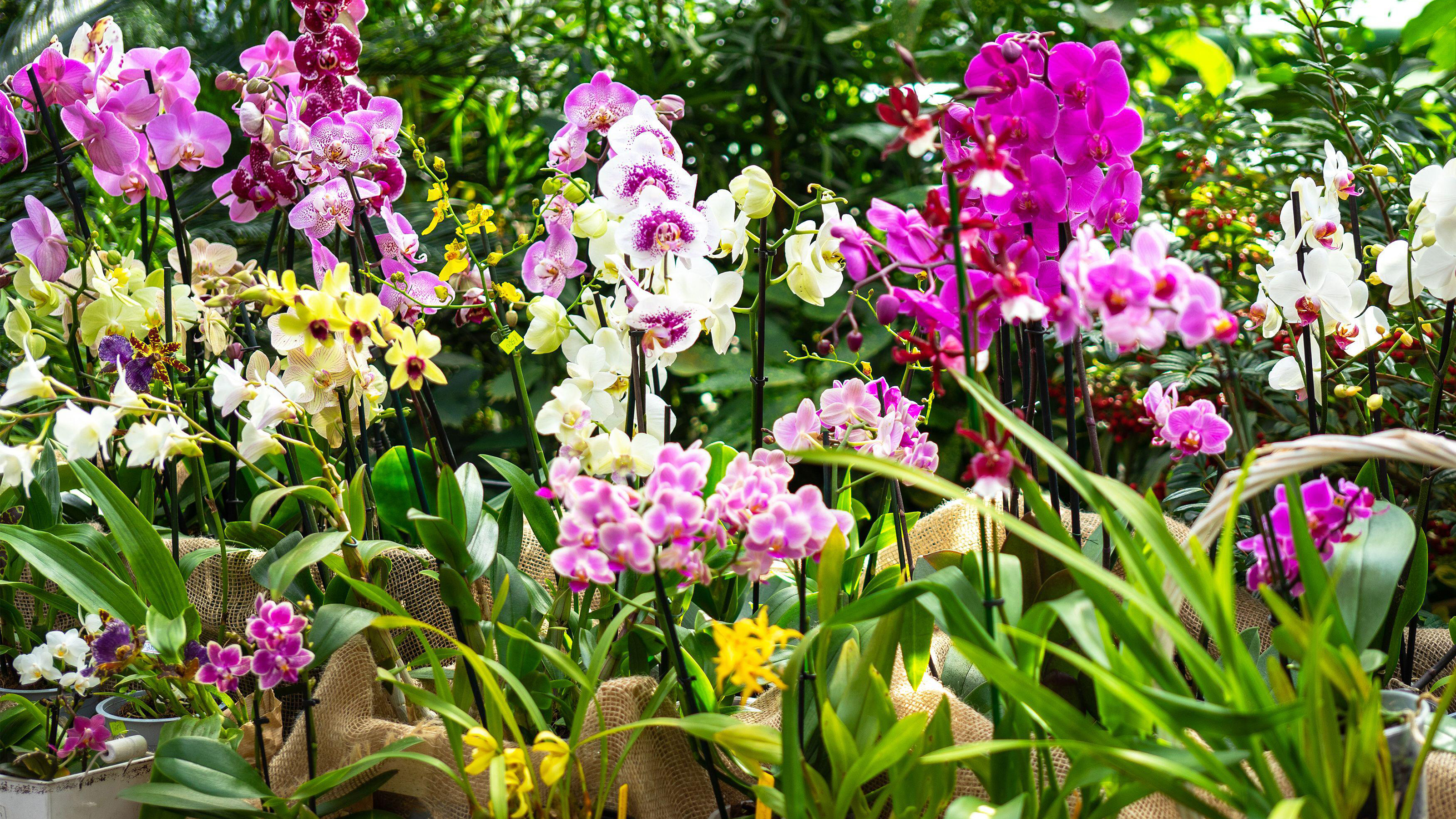
With over 25,000 different types of orchids to choose from, in almost every color of the rainbow, growers are spoiled for choice.
Some exotic or unusual orchids are rarely seen outside specialty shows, or their remote natural habitat, while others are readily available to the novice grower.
Despite having a reputation for being difficult to grow, many orchid types will thrive as houseplants and don't need to be kept in a greenhouse. While other species are well suited to growing in the garden.
Orchid care must be tailored to the individual variety and its compatibility with the growing environment.
How To Choose Between Types Of Orchids
In this guide, we give an overview of the optimum temperature, humidity, and light requirements of different species of orchids.
Choose an orchid that fits in with your home or garden, rather than trying to change your environment to fit the orchid.
If you are a beginner grower, select plants classed as "Easy". Just because a plant is more difficult to grow, it isn't necessarily more beautiful. However, "Intermediate" and "Advanced" orchids offer a challenge for more experienced growers.
Sign up for the Gardening Know How newsletter today and receive a free copy of our e-book "How to Grow Delicious Tomatoes".
Most orchids are prized for their beautiful flowers, so opt for orchid varieties with long bloom times or frequent flowering periods.
Bear in mind, that to get an orchid to rebloom, most species require a drop between day and nighttime temperatures of 10°F to 15°F (5°C to 8°C).
Popular Orchid Varieties To Grow Indoors
With so many types of orchids to choose from, it's hard to know where to start. These popular indoor varieties are widely available to purchase from stores such as Home Depot, Walmart, and The Sill, and there is a wealth of care information available for each species.
Cattelya Orchid

Often referred to as the corsage flower, the Cattleya orchid is a native of South America and loves heat and light.
It produces some of the most colorful, unique flowers in the orchid world and with proper care can last for decades.
Grow Cattleya orchids in rooms that feel almost stuffy and place them where they can get as much sunlight as possible without burning them.
- Difficulty level: Easy
- Daytime temperature: 70-85°F (24-30°C)
- Humidity: 50-80%
- Light: Bright, indirect
Cymbidium Orchid
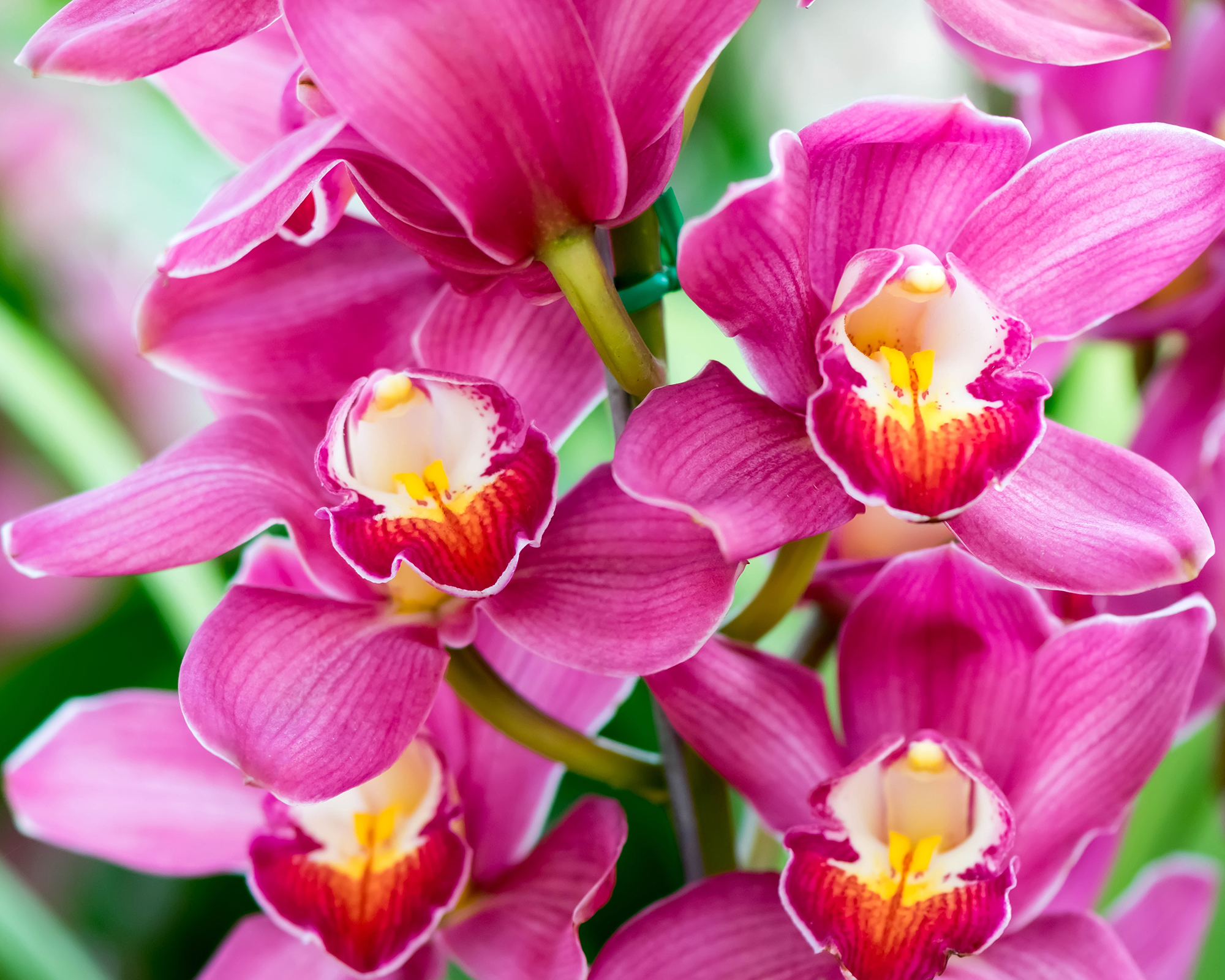
The Cymbidium orchid – or boat orchid – is a real showstopper that can produce up to 30 flowers on one spike, lasting months at a time.
It’s a great choice of houseplant, but can also be grown in the garden, as long as it is protected from frosts and receives plenty of water in warmer months.
Indoors, Cymbidiums are ideal for cool, bright rooms.
- Difficulty level: Easy
- Daytime temperature: 50-80°F (10-27°C)
- Humidity: 50-60%
- Light: Bright
Dendrobium Orchid
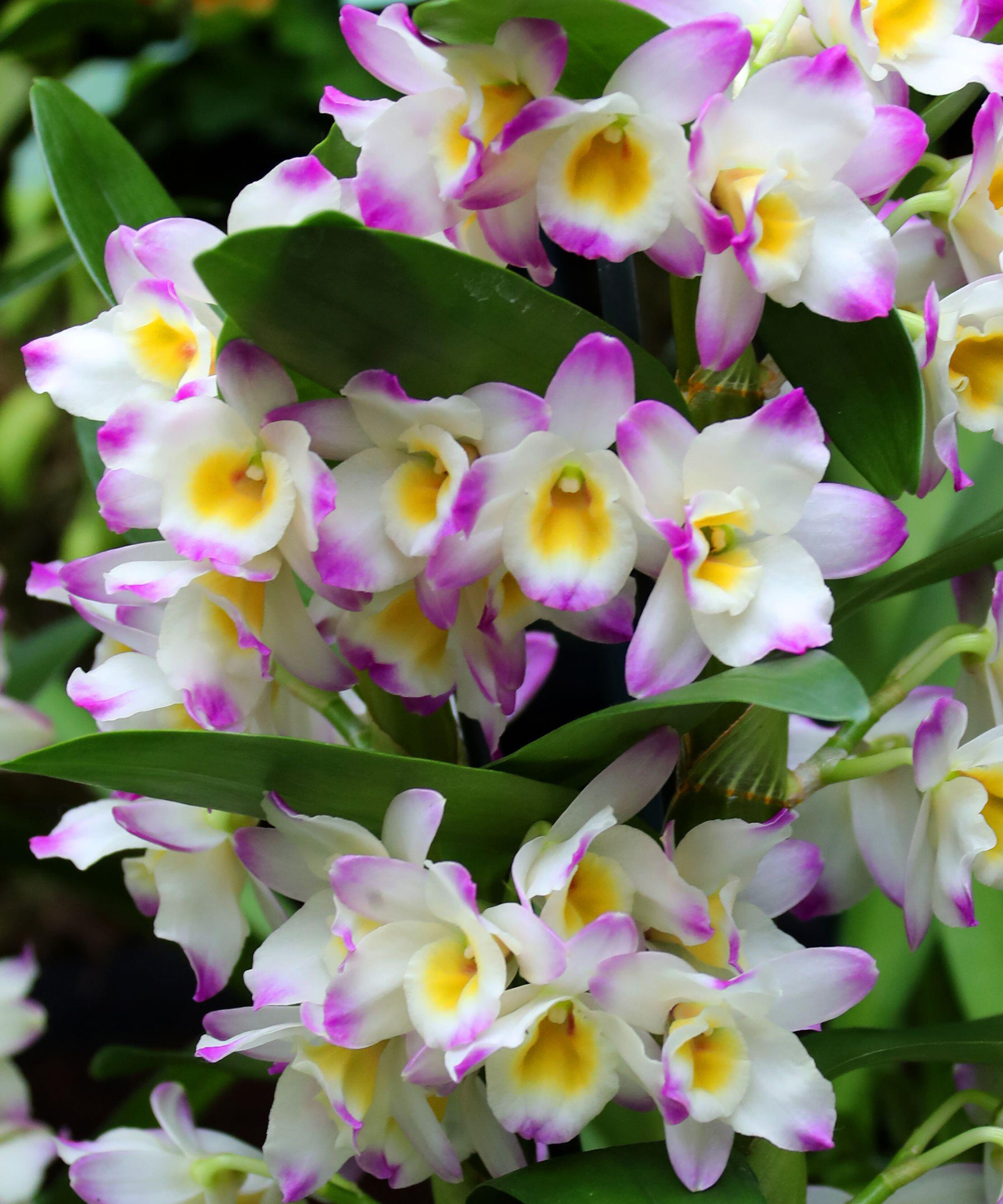
Tougher than many other varieties, the Dendrobium orchid is often recommended for people who are afraid to grow orchids. Dendrobium is a catch-all orchid species, with popular varieties including Nobile and Kingianum.
Plants tolerate lower moisture in the air than other varieties and can take a wide range of air temperatures.
Their flowers are particularly beautiful, with up to 50 blooms on one stem, and can last up to four weeks.
Plant dendrobium orchids in a small pot, as they need their roots to be crowded in order to thrive.
- Difficulty level: Easy
- Daytime temperature: 65-75°F (18-24°C)
- Humidity: 50-70%
- Light: Bright, indirect
Epidendrum Orchid
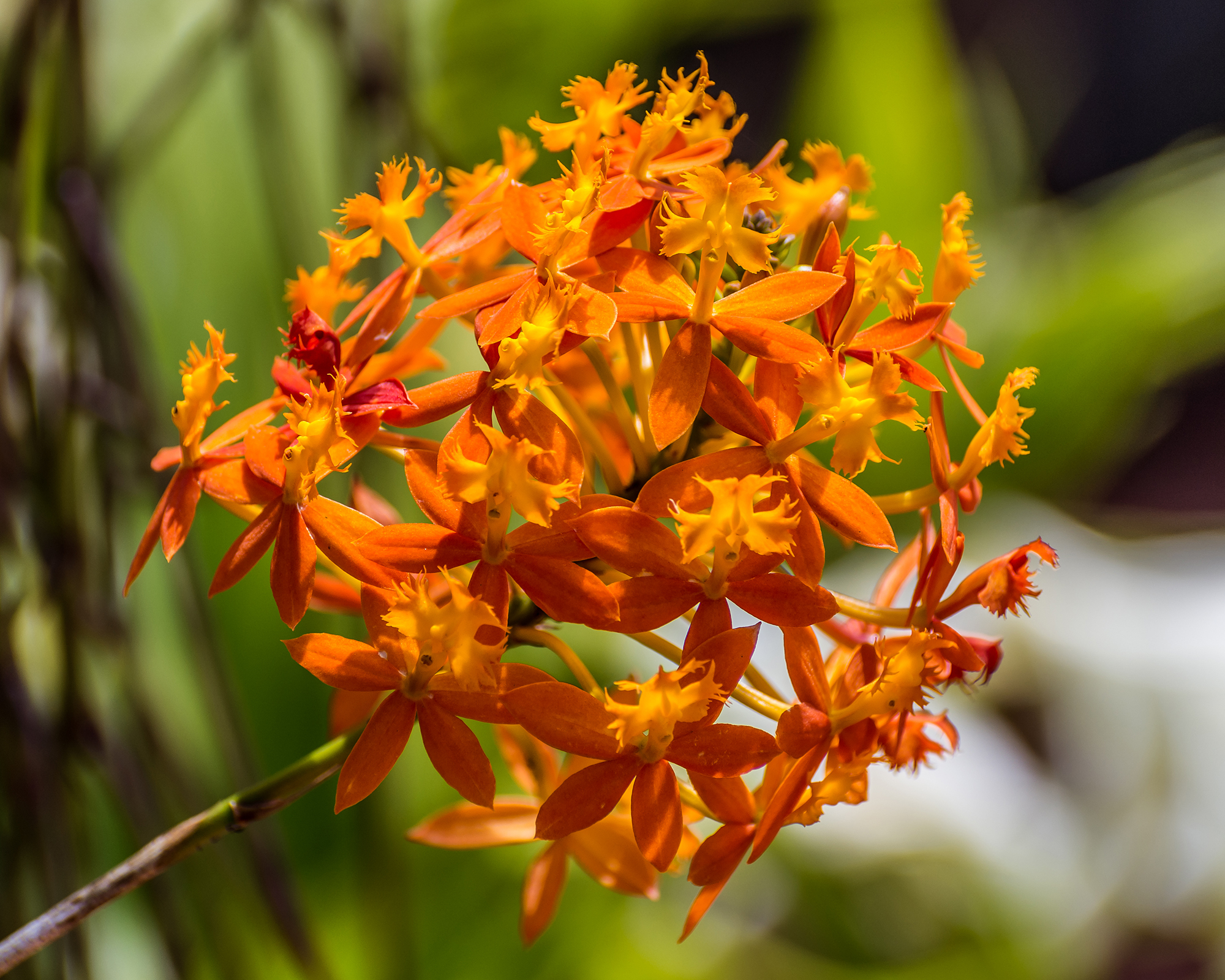
Encompassing many species with either pseudobulbs or cane-like stems and various sizes, the Epidendrum orchid family is ideal for growing indoors. However, they can be grown outdoors in warmer areas, particularly in Florida.
Epidendrums are low-maintenance, but the flowers are nearly ever-blooming and highly fragrant. Plants prefer warm temperatures, filtered to bright light, and high humidity.
- Difficulty level: Easy
- Daytime temperature: Above 50°F (10°C)
- Humidity: 50-80%
- Light: Bright, filtered
Ludisia Jewel Orchid
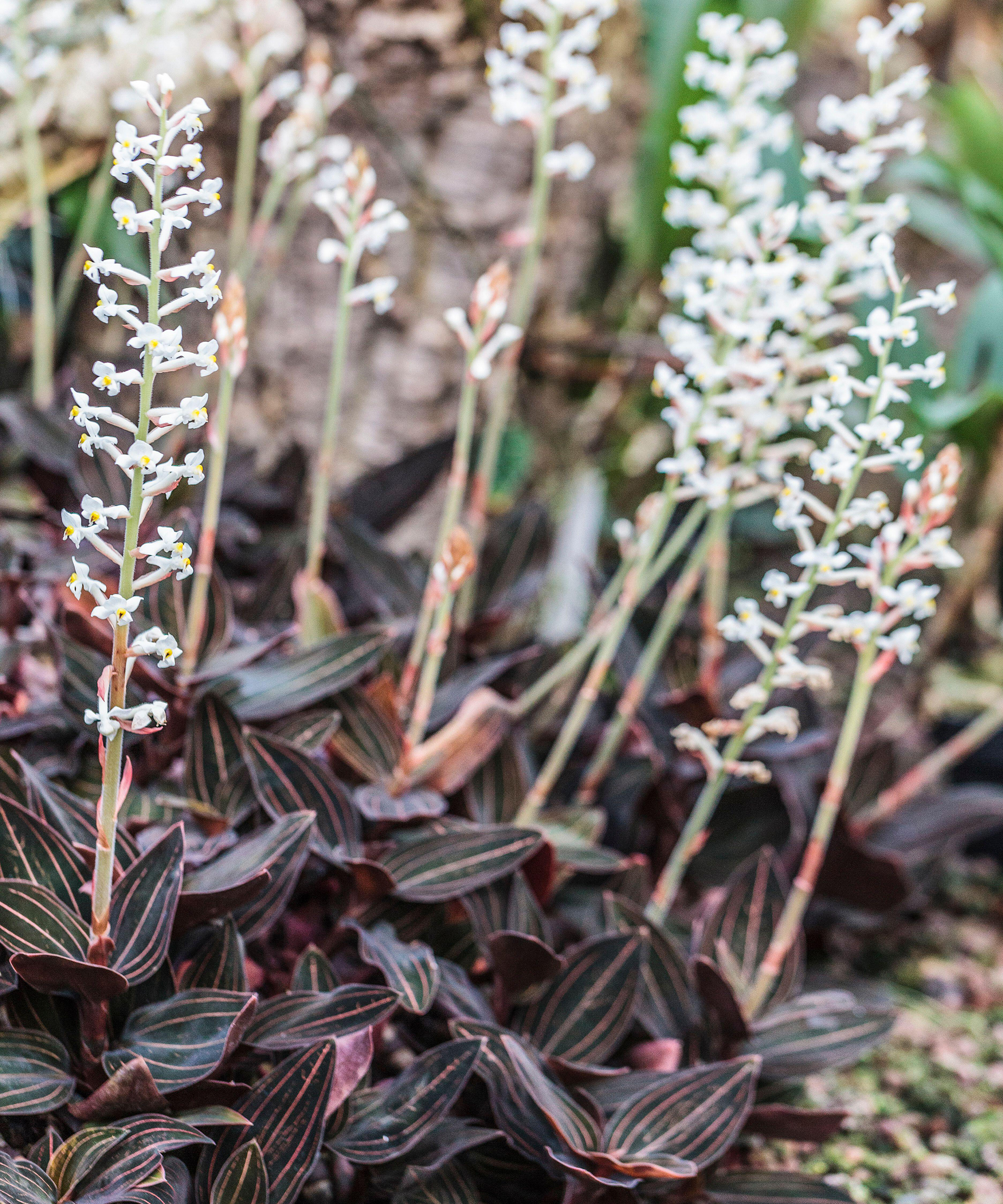
Ludisia, or jewel orchid, is an unusual variety that is easy to grow. Unlike most orchids, its leaves are the star of the show, which are velvety in texture and red and green in color.
It also produces white or pale yellow flowers, mostly during the winter or early spring.
Plants are easy to propagate by breaking off a piece of rhizome and rooting it in soil.
Ludisia is a terrestrial orchid, which means it needs to be planted in soil rather than orchid potting mix. A commercial African violet mix is ideal.
- Difficulty level: Easy
- Daytime temperature: 60-80°F (16-27°C)
- Humidity: 50-70%
- Light: Medium to bright, indirect
Miltonia Orchid
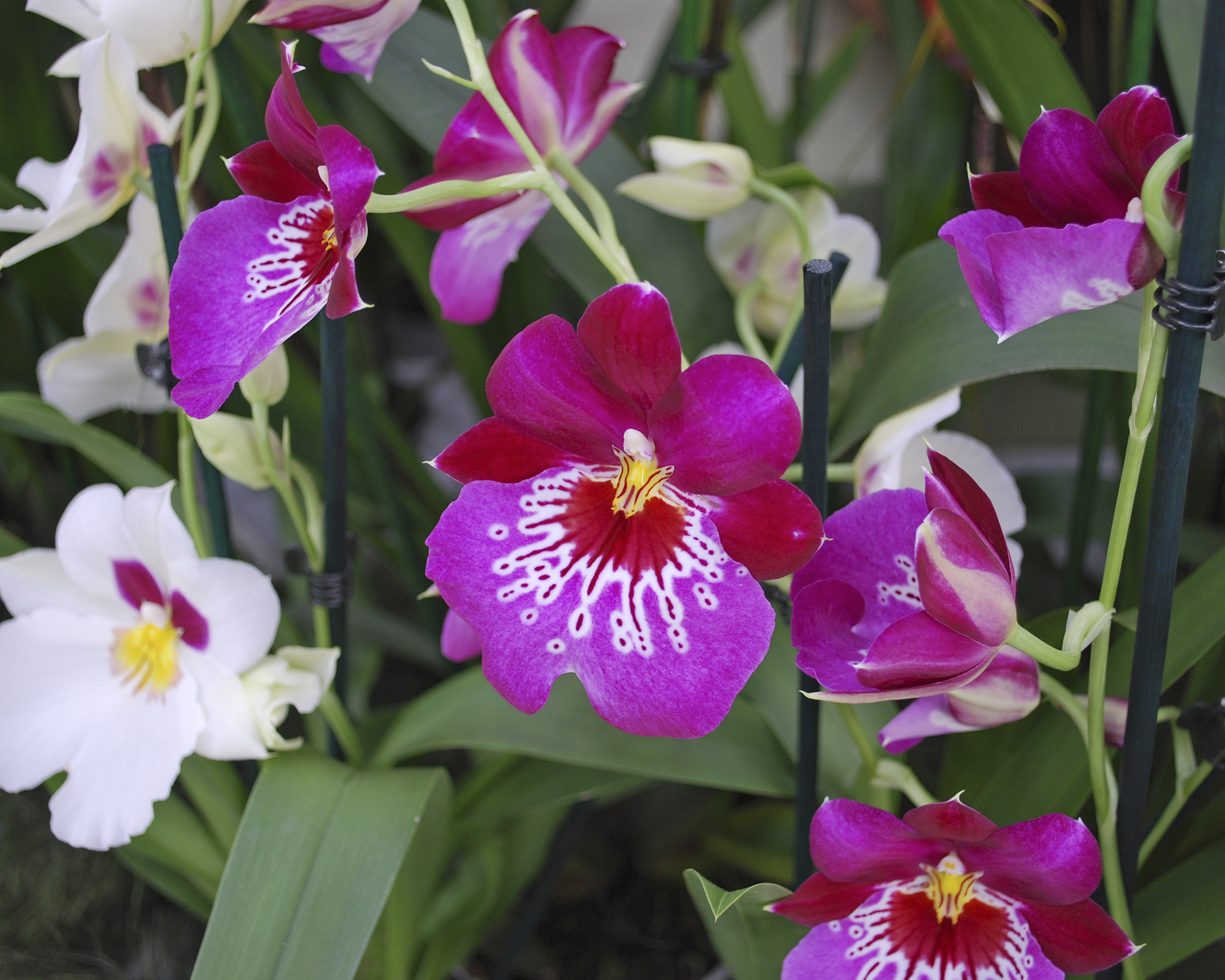
Often called the “pansy orchid” because of its open, flat flowers, the Miltonia orchid family is divided into warm-growing, small-flowered varieties and cool-growing, large-flowering types.
These plants will bloom early in the spring and the flowers will last up to five weeks. Some hardy varieties will bloom again in the fall,
Miltonia orchids like filtered to shady light, high humidity, good air circulation, and evenly moist mediums. They struggle in periods of high heat.
- Difficulty level: Intermediate
- Daytime temperature: 70-80°F (21-27°C)
- Humidity: 60-80%
- Light: Low to medium
Oncidium Orchid
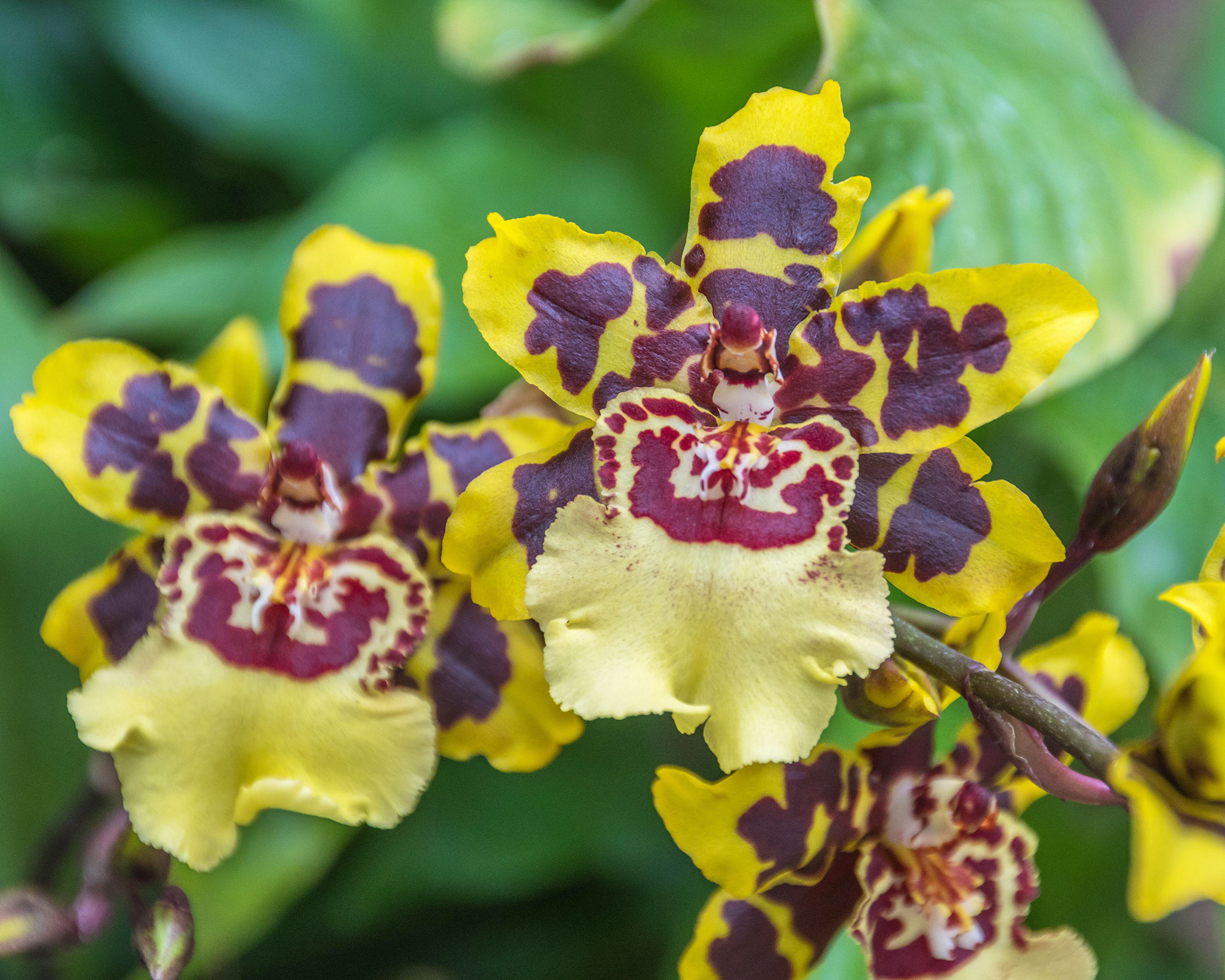
The Oncidium orchid family is vast. Known as “dancing lady”, named for its fluttering flowers, Oncidium's long-lasting blooms are most often found in shades of yellow and brown
These epiphytic orchids prefer to have their roots exposed to the air, hanging over the edge of pots. They are fussy when it comes to temperature, and require an above-average difference between day and night time of up to 20°F (11°C).
- Difficulty level: Intermediate
- Daytime temperature: 70-85°F (24-29°C)
- Humidity: 30-60%
- Light: Bright, indirect
Paphiopedilum Orchid
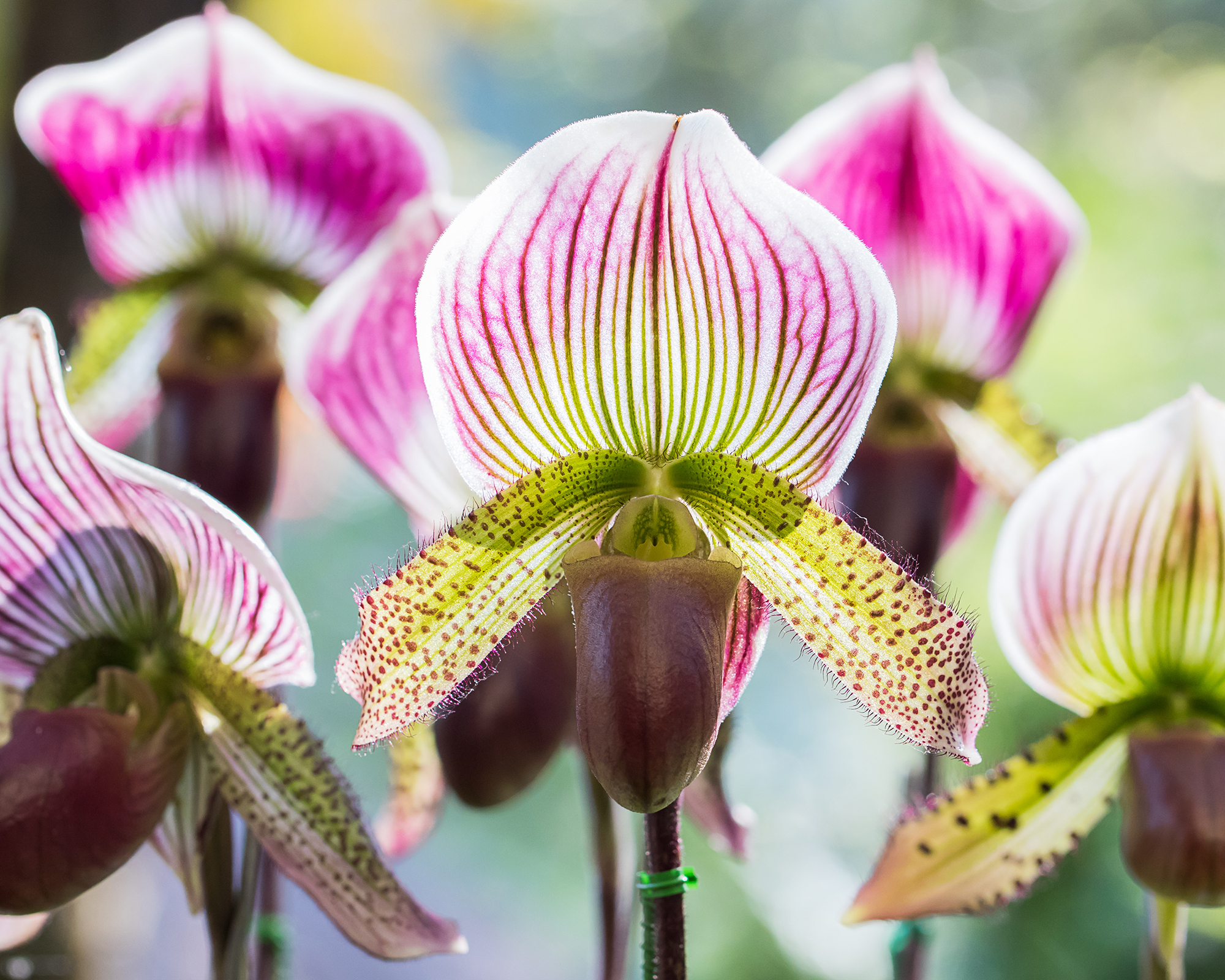
The Paphoipedloium orchid – or slipper orchid – is easy to care for but prized by collectors for its stunning, long-lasting blooms that can endure for three months. It’s a varied species, and some plants have striped or variegated leaves, and others have flowers with spots, stripes, or patterns.
Most Paphiopedilum species are terrestrial orchids, which means they grow in soil. Terrestrial orchids should be grown in a pot, not in a hanging mount as is sometimes used for tree-dwelling epiphyte orchids. Growing Paphiopedilum terrestrial orchids outdoors is also possible in tropical and subtropical climates.
There are two types of Paphiopedilum: warm and cool, requiring different temperatures. Although all require low lighting.
- Difficulty level: Easy
- Daytime temperature: Warm varieties 75-85°F (23-29°C); cool varieties 75-80°F (23-26°C)
- Humidity: 40-50%
- Light: Low
Phalaenopsis Orchid
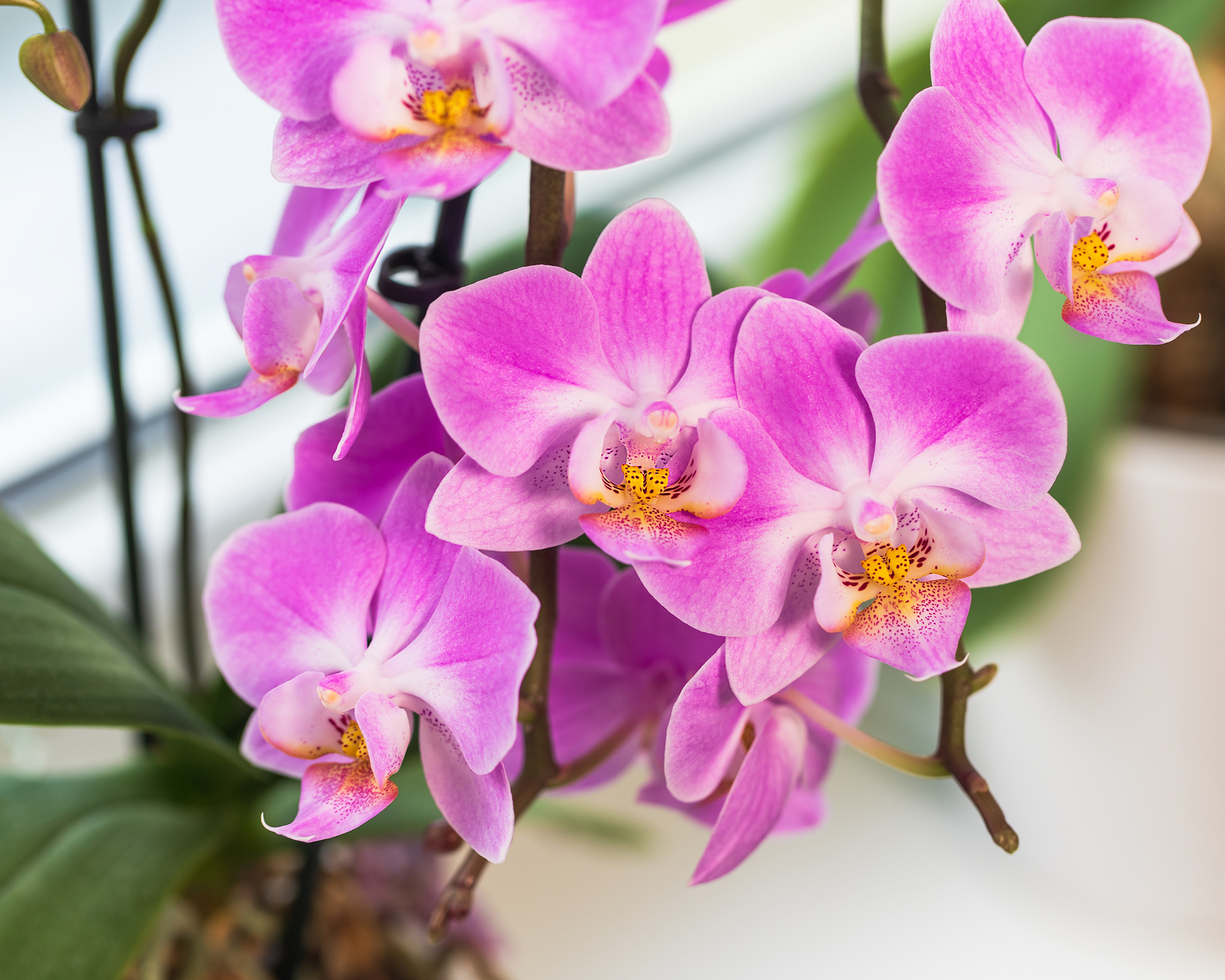
Phalaenopsis orchid, also known as the moth orchid, is the most popular houseplant variety. It’s a great choice for beginner growers as it is fairly hardy and has showy, exotic-looking flowers.
Phalaenopsis blooms once or twice a year, and each flower can last up to three months with the proper care.
- Difficulty level: Easy
- Daytime temperature: 65-75°F (18-24°C)
- Humidity: 50-80%
- Light: Diffused or low light
Vanda Orchid

The Vanda orchid produces some of the most stunning flowers in the orchid world. Its family is divided into two main groups based on the shape of the plant’s leaves: strap-leaved (will bloom indoors) and terete-leaved, which are round and pencil-shaped (does not bloom inside).
Vanda orchids bloom several times a year with flowers available in a range of colors. The foliage is thick and round, with a glossy waxy sheen. Plants range in size from miniatures to several feet tall, requiring support.
- Difficulty level: Easy
- Daytime temperature: 70-90°F (20-32°C)
- Humidity: 60-80%
- Light: Strap-leaved bright, indirect; terete-leaved bright, direct
Orchids To Grow In The Garden
Wild orchids mainly grow in warm, humid environments. However, there are orchids in almost every part of the world, including colder areas.
Here we reveal the most common orchids that may be grown in gardens. Native orchids are most likely to thrive but check that the species is compatible with your USDA planting zone before investing.
Bletilla Striata
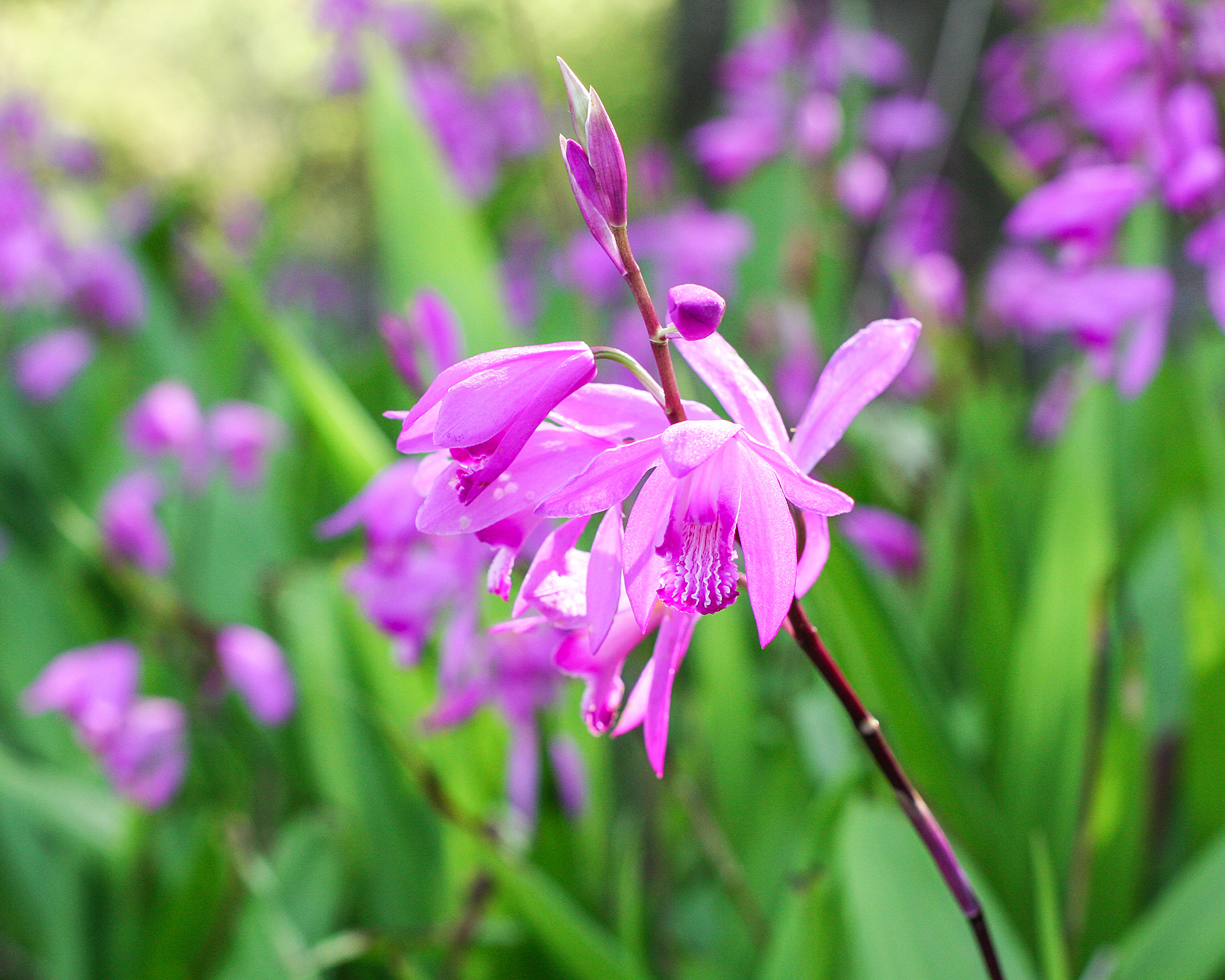
Also called the hardy Chinese ground orchid, Bletilla striata is native to China and Japan, but happily grows in many gardens in the US and the UK.
The orchid's elegant pink-to-purple flowers bloom in the spring, and will readily naturalize where optimum growing conditions are met through rhizomes.
It's ideal for growing in containers, and in cooler areas plants can be overwintered indoors.
- Difficulty level: Easy
- USDA hardiness zones: 5-9
- Soil requirements: Well-draining, rich
- Sun exposure: Partial shade
Calanthe Orchid

Often referred to as the Christmas orchid, Calanthe is a genus of orchids made up of only five species. They can be categorized as either evergreen or deciduous. Both types have a long bloom period, and the latter needs pruning in the fall.
Most Calanthe orchids are hardy in USDA zone 7, but they may be planted in zone 6 if protected from frost. This makes them a good candidate for growing in containers.
- Difficulty level: Easy to Intermediate
- USDA hardiness zones: 6-11
- Soil requirements: Well-draining, rich
- Sun exposure: Partial shade
Calopogon Tuberosus Orchid
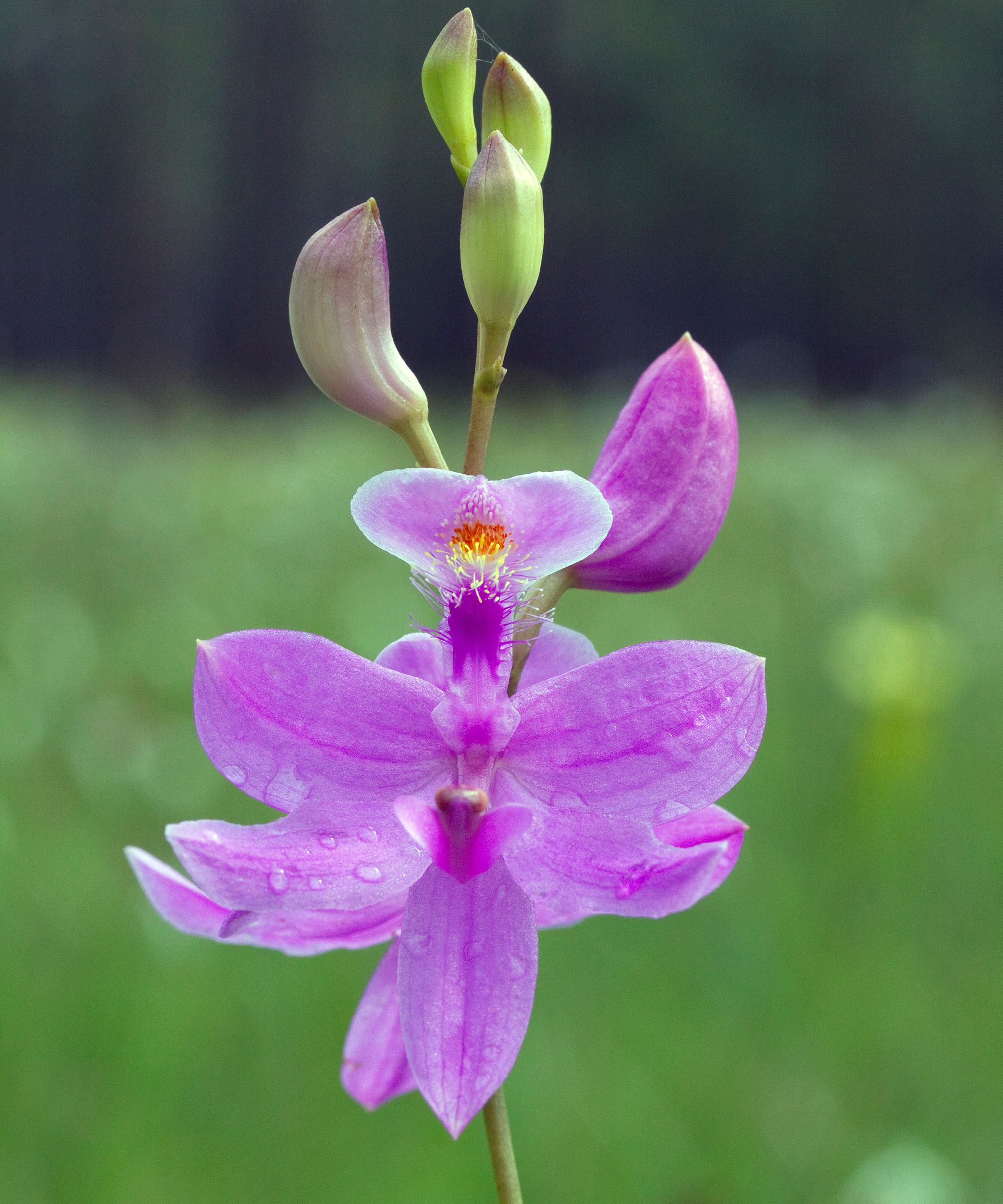
Native to North America and parts of the Caribbean, Calopogon tuberosus – also known as the "grass pink" orchid – thrives in bogs and wetlands in the wild, and may also be spotted in prairies with wet depressions.
These orchids require constant moisture, so ideally plant at the side of a stream so that the roots get fresh, clean water. You can try growing them at the edge of a pond, but disease is a risk.
Calopogon tuberosus is rare and should never be collected from the wild. Find a specialist nursery that cultivates the flowers.
- Difficulty level: Intermediate
- USDA hardiness zones: 3-9
- Soil requirements: Wet, but well-draining
- Sun exposure: Full sun
Epipactis Orchid

The Epipactis orchid (Epipactis helleborine) is a rarity in that, in certain environments, it can become invasive and take over.
Native to Europe, Epipactis now grows all over the eastern and central US and Canada, as well as in some places in the west.
The root system is large and fibrous, and the plants produce stems reaching 3.5 feet (1m) tall. The flowers are very pretty and bloom in late summer or early fall, with each stem producing as many as 50 small flowers. Colors range from bluish-purple to pink-red or greenish-brown.
This species is low maintenance but check with your county extension office whether it is invasive in your area before planting.
- Difficulty level: Easy
- USDA hardiness zones: 2-9
- Soil requirements: Light, well-draining
- Sun exposure: Full sun
Ladies Tresses Orchid

Ladies tresses orchid (Spiranthes cernua) grows wild throughout most of the central and eastern areas of the United States and Canada.
A terrestrial orchid, it produces fragrant clusters of small white, yellow, or greenish flowers on spiky stems reaching heights of up to two feet (61cm).
Ladies tresses orchids are easy to grow, and slowly colonize via underground rhizomes. Don’t attempt to remove plants from the wild – they can be found at nurseries that specialize in wildflowers or native plants.
- Difficulty level: Easy
- USDA hardiness zones: 5-9
- Soil requirements: Moist, acidic
- Sun exposure: Partial shade
Lady Slipper Orchid
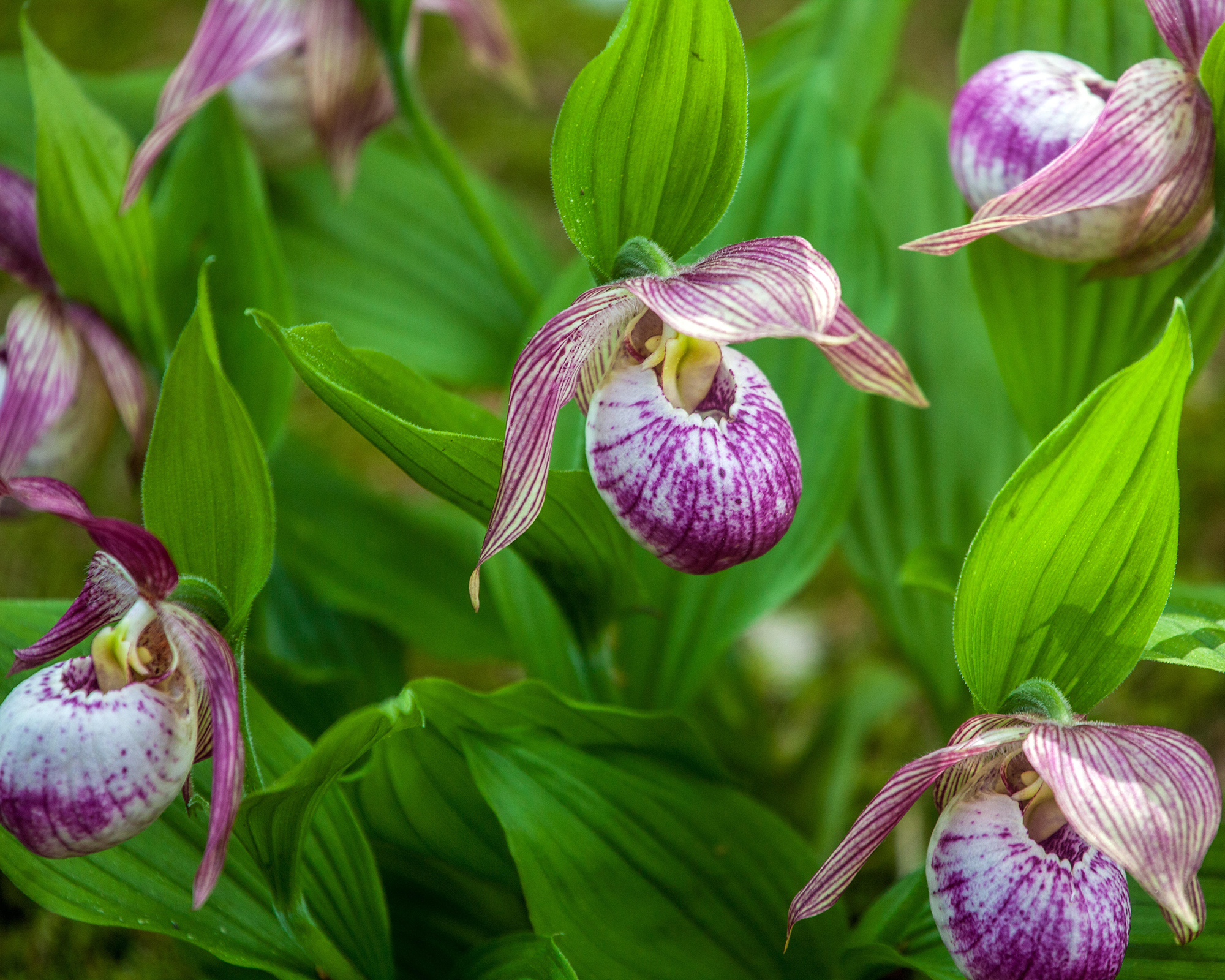
The native lady slipper orchid (Cypripedium) is a special sight to behold in the wild. Yet, adding them to the garden is not a difficult feat. They are particularly well suited to woodlands, so try growing them in dappled sunlight under tall trees.
There are numerous varieties, some of which are endangered, but many can be easily sourced through nurseries. Flowers come in white, yellow, pink, and almost purple.
Lady slippers need well-aerated soil and moist conditions in order to thrive.
- Difficulty level: Intermediate
- USDA hardiness zones: 3-8
- Soil requirements: Moist but well-draining and aerated
- Sun exposure: Partial shade
Spathoglottis Ground Orchid
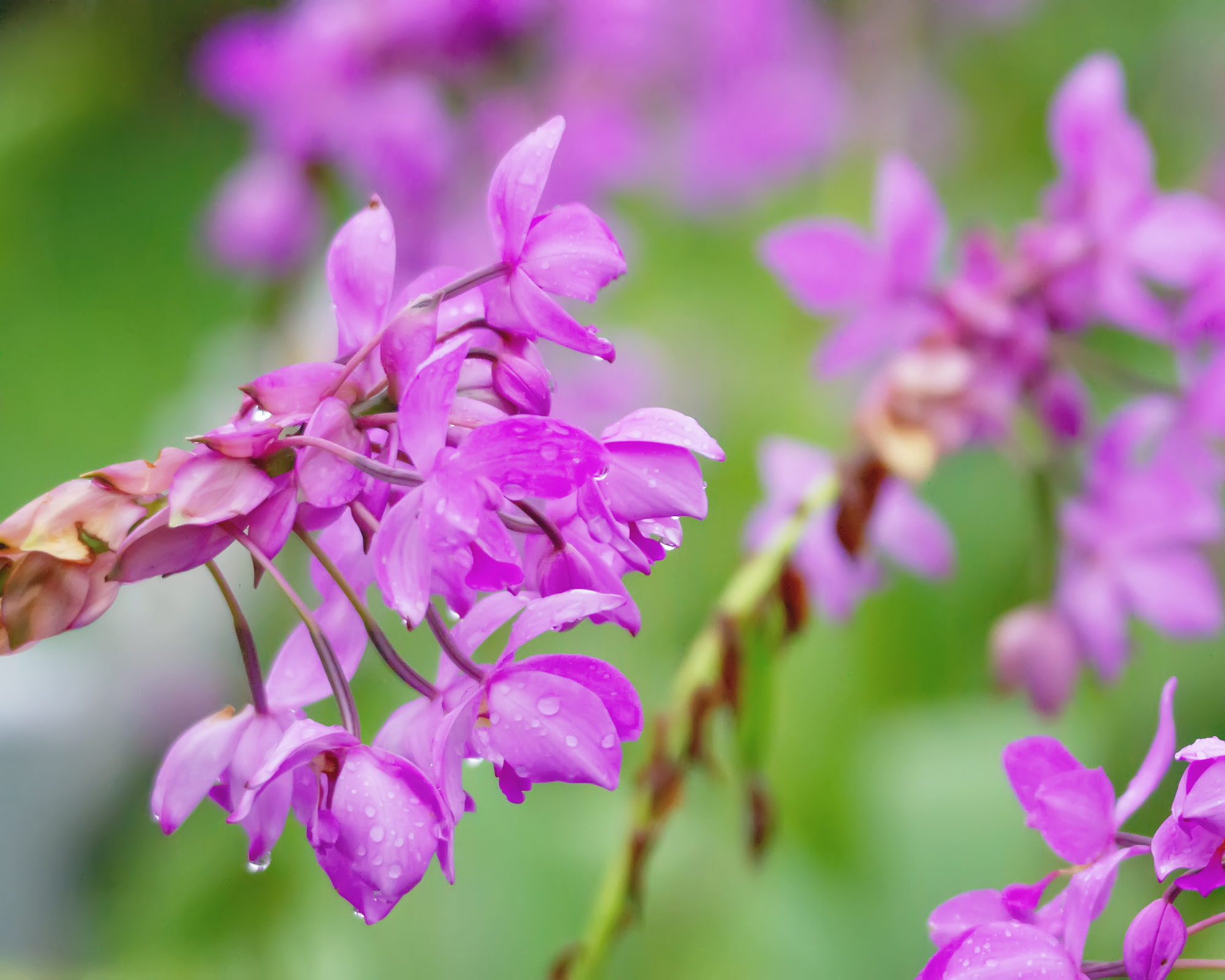
Also known as the ground orchid, the Spathoglottis orchid thrives outdoors in a warm environment. However, those in cooler areas can grow them in containers and bring them indoors in the cold months.
The brightly colored flowers come in a range of hues, and bloom for long periods throughout the growing season, reaching 2 feet (61cm) tall.
As a terrestrial orchid, Spathoglottis grows in soil, though it's best to plant it in a water-retentive potting mix, such as fir bark mixed with peat moss and perlite.
Spathoglottis is a versatile orchid that tolerates light shade to full sunlight. However, warm air temperature is non-negotiable. They require temperatures in the 80s during the day and no cooler than 50°F (10°C) at night.
- Difficulty level: Easy
- USDA hardiness zones: 9-10
- Soil requirements: Well-draining, rich
- Sun exposure: Partial shade to full sun
White Egret Orchid
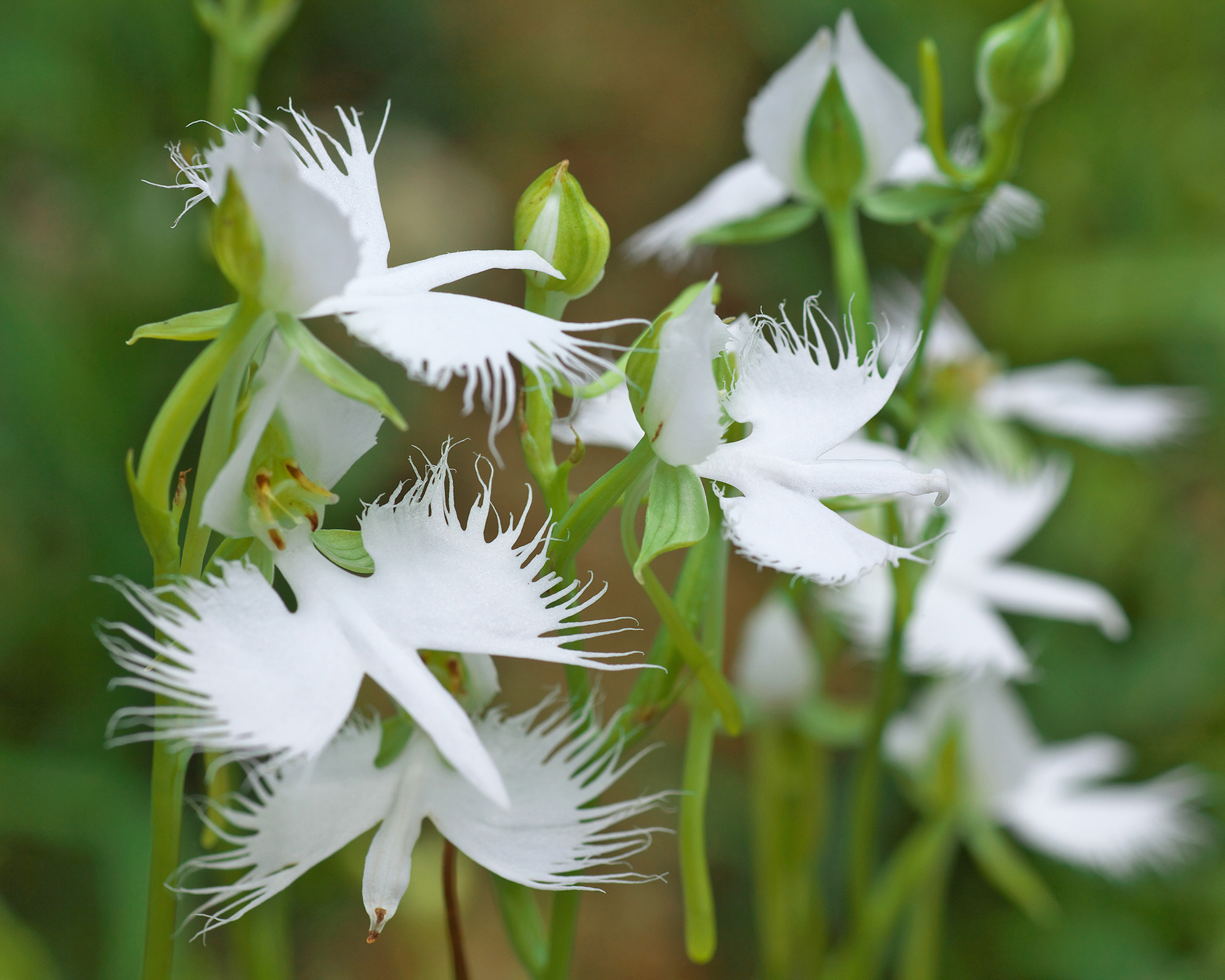
Also known as the crane orchid, the white egret orchid (Habenaria radiata) is named for its striking resemblance to birds in flight.
The beautiful fringed flowers have strappy, deep green leaves and grow primarily in grassy wetlands, shady glades, or bogs.
While the Asia natives are endangered in their natural habitat, they will multiply generously in gardens when well-suited to the environment.
The white egret orchid is suitable for growing in USDA zones 5 through 10, although with proper care and ample mulch, it may tolerate more northern climes. Alternatively, grow them in pots and overwinter indoors.
- Difficulty level: Easy to Intermediate
- USDA hardiness zones: 5-10
- Soil requirements: Moist but well-draining
- Sun exposure: Partial shade to full sun
Rare & Unusual Orchids
If you're looking to enrich your home or garden with a more unusual variety of orchid, then you will find one among these rarer species.
Bear in mind, that rare orchids may be more difficult to grow, so start with a more common houseplant type before graduating to an expert variety.
Bee Orchid
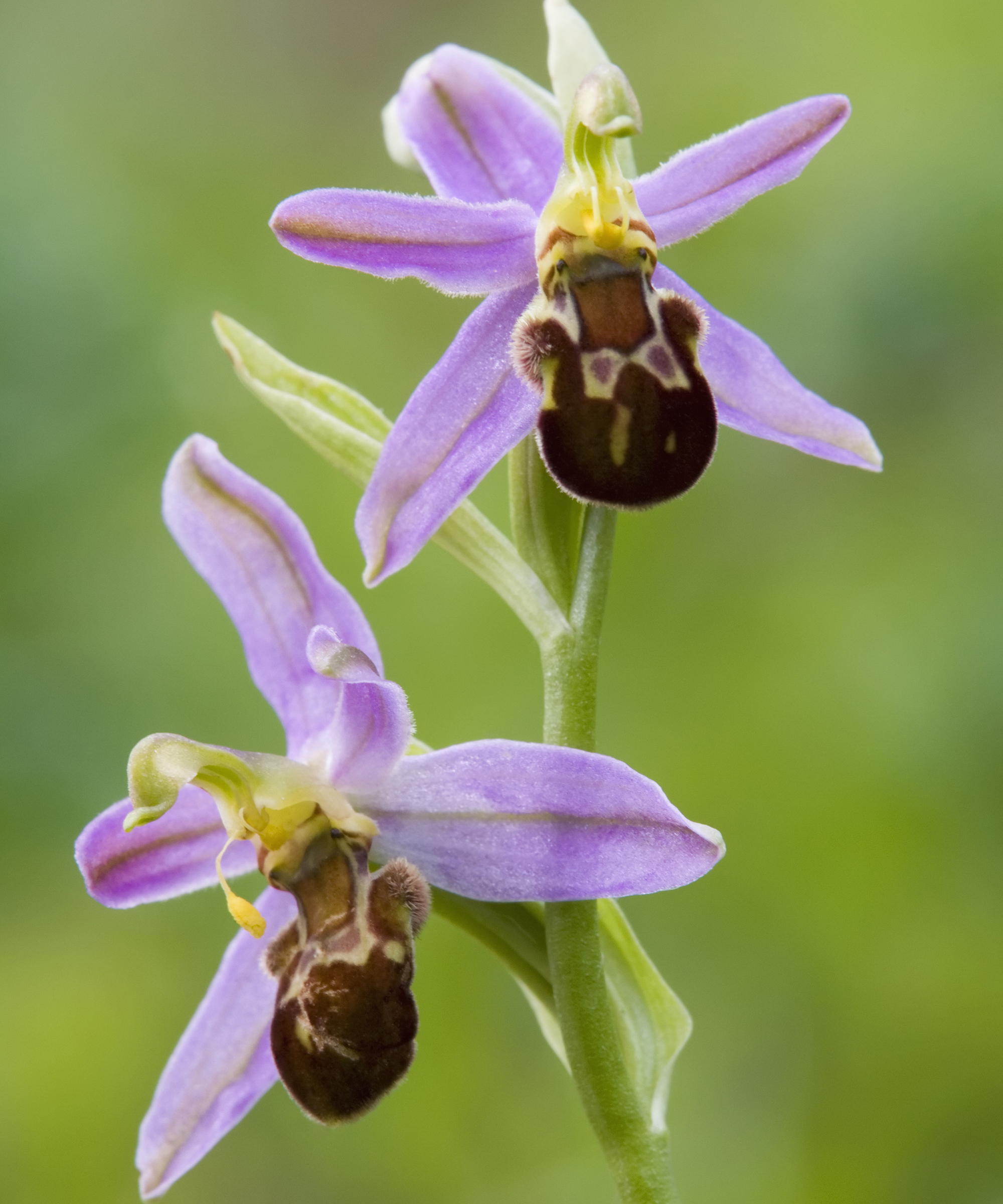
Native to Europe, the bee orchid – or Ophrys apifera – has evolved to look like a bee to attract the precious pollinators. Despite this, it is self-fertile.
In the US, the orchid can be grown outdoors in hardiness zones 6-9. It is not widely available, but seeds can be sourced from specialist retailers. Unfortunately, it takes several years for bee orchids to reach flowering maturity.
Plant bee orchids in a location free of pesticides and herbicides, as they may kill the plants, which also do not require fertilizing. When well suited to the growing environment, bee orchids will naturalize in lawns.
- Difficulty level: Easy to Intermediate
- USDA hardiness zones: 6-9
- Soil requirements: Most neutral to alkaline soil types
- Sun exposure: Partial shade
Brassavola Orchid

Despite its ethereal appearance and lesser-known status, the Brassavola orchid is easy to grow and ideal for beginners.
In particular, Brassavola nodosa is a prized species. Its white flowers are understated but possess a delicious citrus-like fragrance, which is only emitted at night.
Brassavola nodosa is smaller than some other species of orchid and has pseudobulbs, which help plants to retain moisture.
- Difficulty level: Easy
- Daytime temperature: 65-80°F (18-27°C)
- Humidity: 50-80%
- Light: Bright, indirect
Cataseum orchid

The Catasetum orchid is a fascinating species that will often discharge its pollen masses onto pollinators. It is unique in that it mostly produces separate male and female flowers but can also have hermaphroditic blooms.
Plants have striking waxy flowers with distinct flowering and rest periods. When resting, they will lose their leaves. During dormancy, the orchids don’t require much care and should be allowed to dry out significantly.
Catasetums require less care than many orchids but do have high heat requirements. They are ideal for growing in a greenhouse or outside in a warm climate.
- Difficulty level: Easy to Intermediate
- Daytime temperature: 80-100°F (27-38°C).
- Humidity: 40-60%
- Light: Bright
Ghost Orchid
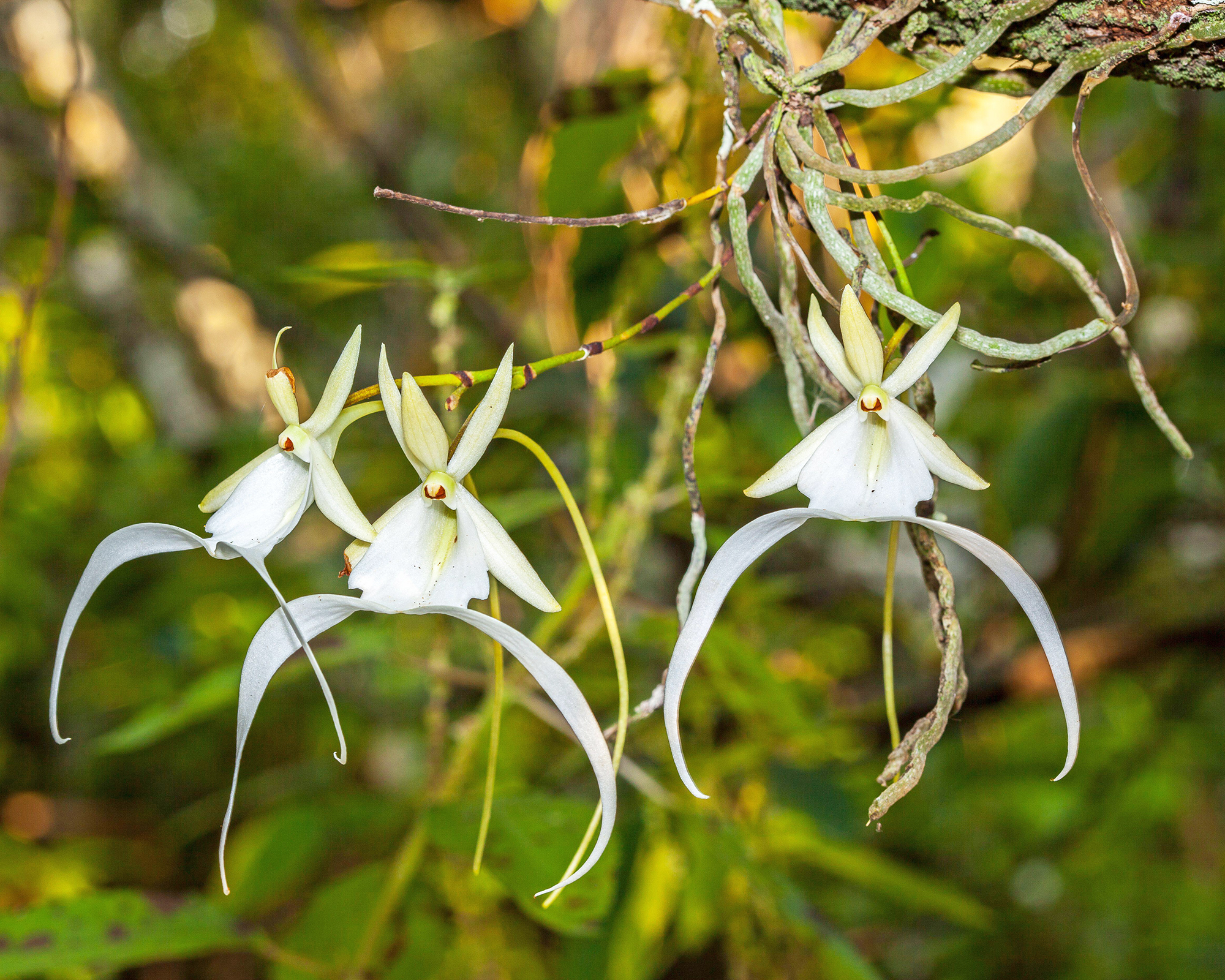
The elusive ghost orchid (Dendrophylax lindenii) is an endangered native species that is popular among growers seeking a challenge.
Ghost orchids have no foliage, but possess graceful white flowers that emit a sweet scent at night. Their striking aerial roots need to be mounted onto tree bark, rather than planted into potting mix.
Sadly, the ghost orchid is rare for a reason, as it is extremely difficult to grow in the home environment. Many have tried and failed. However, if you want to try to beat the odds, it's worth knowing that the plant is well suited to growing in an orchid terrarium.
- Difficulty level: Advanced
- Daytime temperature: 70-85°F (21-29°C)
- Humidity: 50-80%
- Light: Bright, indirect
Monkey Orchid

The monkey orchid (Dracula simia) is one of the most curious types of orchid. Native to the tropical highland forests of Ecuador, the flowers bear an uncanny resemblance to monkey faces.
They can be grow at home, but take several years to flower. However, plants can bloom at any time of year and have a long lifespan of up to 20 years. The flowers have a pleasant citrus scent.
Monkey orchids require cooler temperatures with plenty of humidity and moisture, and low light levels.
- Difficulty level: Intermediate
- Daytime temperature: 60-85°F (16-29°C)
- Humidity: 70-80%
- Light: Low, indirect
Tulip Orchid

Widely known as the tulip orchid, Anguloa uniflora is native to the Andes regions around Venezuela, Columbia, and Ecuador. It's also known as the swaddled baby orchid, due to its appearance of a tiny baby swathed in blankets in the flower interior.
Tulip orchids' cream-colored petals are waxy and smell of cinnamon scented. The flowers are long-lasting.
While these elegant orchids can be grown outdoors in USDA zones 11 to 13, they are also good candidates for houseplants or growing in a heated greenhouse. However, they like high humidity and plenty of misting.
- Difficulty level: Intermediate
- Daytime temperature: 60-80°F (16-27°C)
- Humidity: 70-80%
- Light: Medium, filtered
Vanilla Orchid
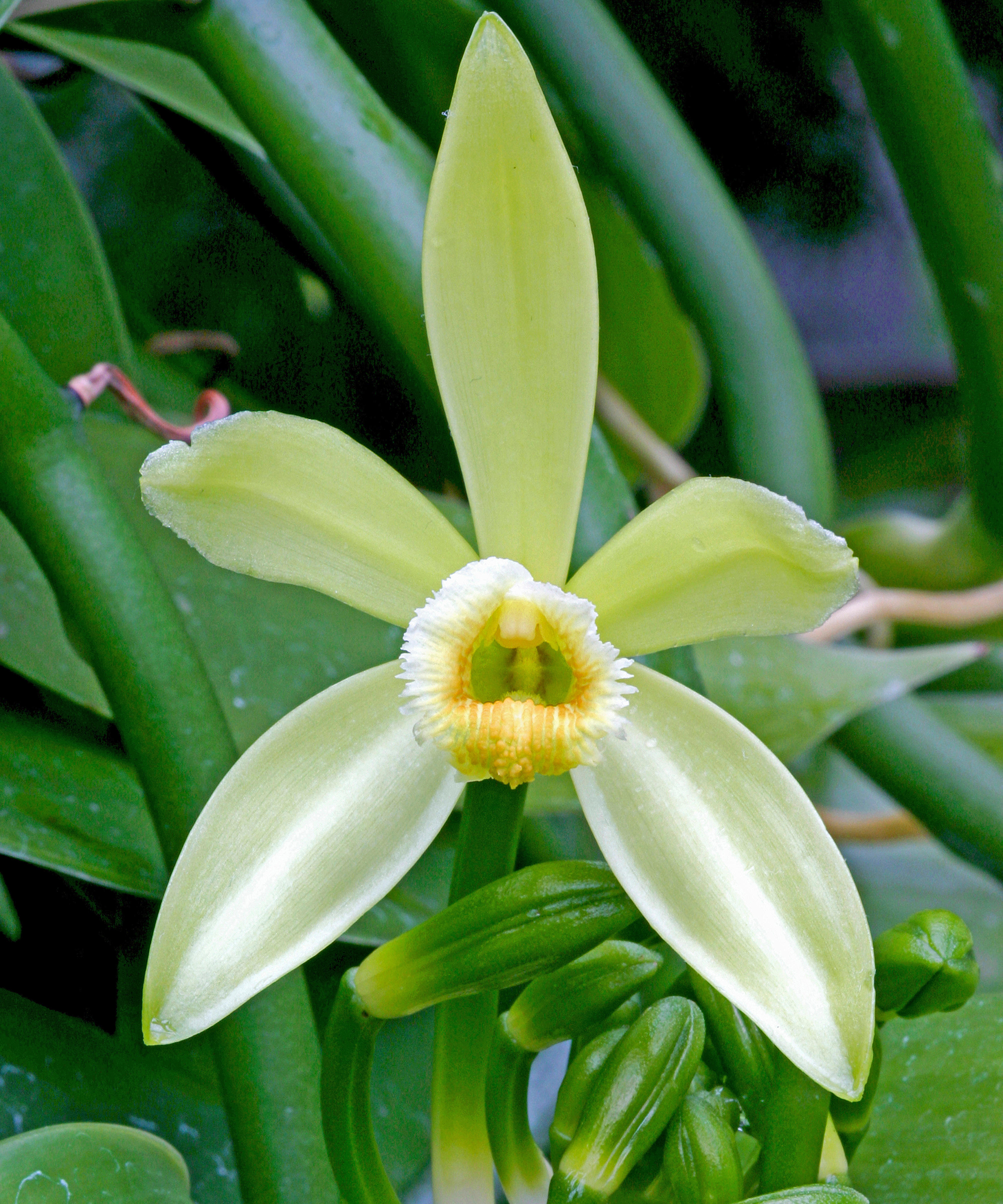
You may be surprised to know that vanilla comes from orchids – specifically the vanilla orchid, Vanilla planifola.
While their vines make an attractive addition to the home, Vanilla orchids have an exacting list of requirements if they are to produce flowers and fruit. Plants require high temperatures of 80-95°F (27-35°C) in the day and 60-70°F (17-16°C) at night, and thrive with humidity and air movement.
If you get everything right, your vanilla vine may bear large greenish-yellow flowers that turn into vanilla pods in eight to nine months.
- Difficulty level: Advanced
- Daytime temperature: 80-95°F (27-35°C)
- Humidity: 70-85%
- Light: Bright, indirect, filtered
Zygopetalum Orchid
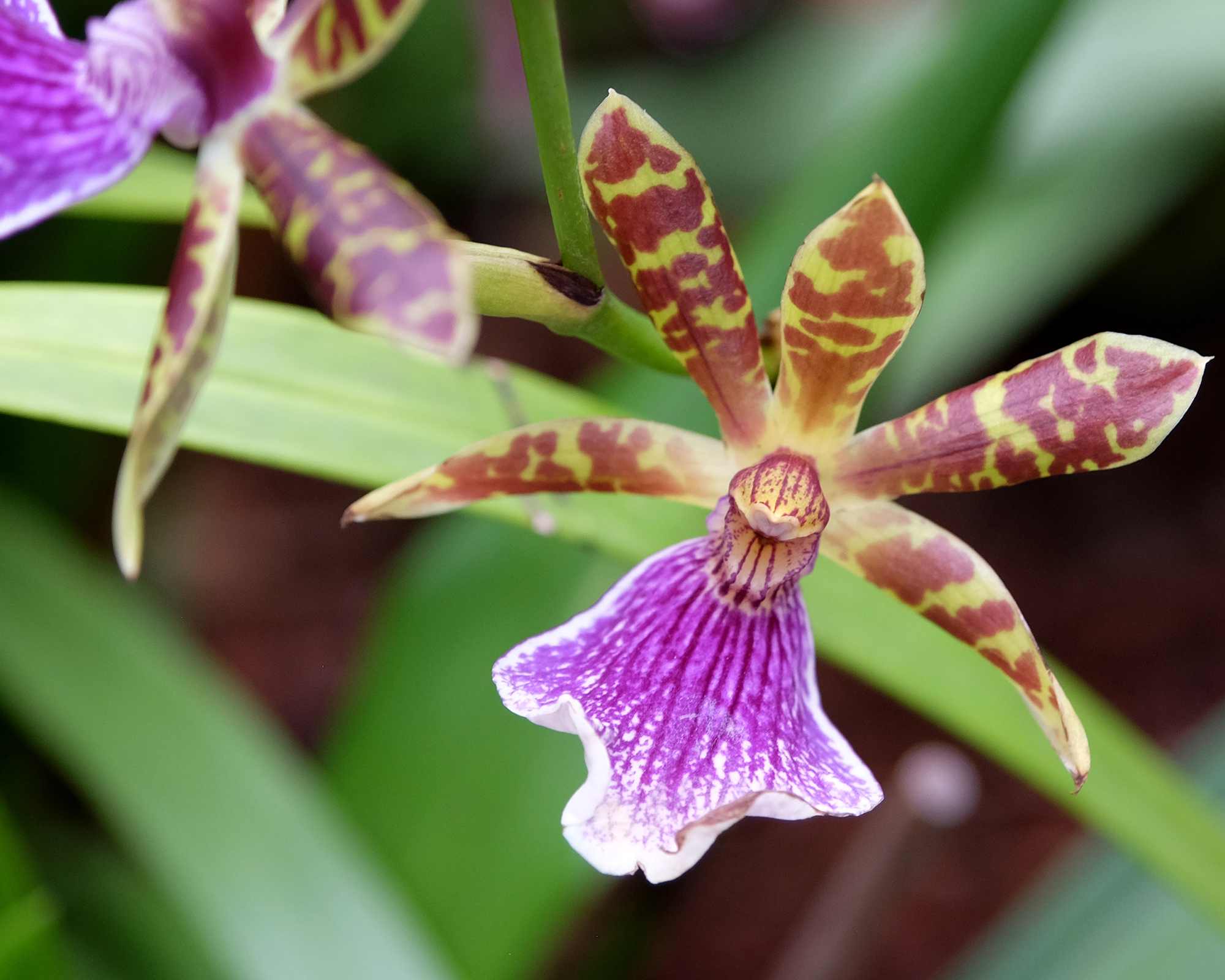
The Zygopetalum orchid has exotic flowers that are highly fragrant – their scent can fill a whole room. Blooms are typically green with brown stripes or spots and a white lip with velvety accents of purple, pink, or maroon.
Native to South America, Zygopetalum has specific care needs and requires intermediate temperatures with plenty of humidity and moisture. However, they are generally trouble-free. Gardeners in USDA zones 9-10 can grow them outside with some shade; otherwise, they can be grown indoors.
These orchids are epiphytes but do not grow aerial roots, so the roots should be planted below the potting medium or right on top of it.
- Difficulty level: Easy to Intermediate
- Daytime temperature: 70-80°F (21-27°C)
- Humidity: 50-70%
- Light: Bright, indirect

Melanie is an experienced gardener and has worked in homes and gardens media for over 20 years. She previously served as Editor on Period Living magazine, and worked for Homes & Gardens, Gardening Etc, Real Homes, and Homebuilding & Renovating. Melanie has spent the last few years transforming her own garden, which is constantly evolving as a work in progress. She is also a passionate organic home grower, having experimented with almost every type of vegetable at some point. In her home, Melanie tends to an extensive houseplant collection and is particularly fond of orchids.